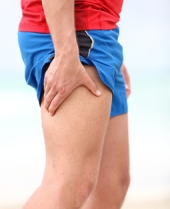Does Foam Rolling Work?
Tuesday, September 9, 2014 - 16:03

The primary purpose of a foam roller is to force a tight muscle to relax thus reducing pain and allow the opposing muscle to contract and stabilize the joint. When this happens, it can help increase range of motion, reduce inflammation, reduce scar tissue, and improve circulation as well as flexibility. They are used as a tool in the self-administered release of tension in soft tissue and are essentially a substitute for the hands, elbows and forearms of a sport massage therapist.
What are trigger points?
Trigger points (also known as muscle knots) are defined as "hyper-irritable spots within a taut band of skeletal muscle” and usually develop in muscles when they are injured or overworked. Trigger points can produce pain in many different areas of the body, most commonly in the low back, neck, jaw, elbow or wrist.
What is self-myofascial release?
The word 'myo' means 'muscle' and the word 'fascia' means the 'band' or 'connective soft tissue' that supports your entire body. Self-myofasical release is a form of soft tissue therapy that you perform yourself. It consists of the slow and gentle application of sustained pressure and is intended to reduce pain and increase mobility in people that are suffering from chronic pain or injury.
Why does foam rolling hurt?
A foam roller is a cylinder made of different lengths and densities or ‘hardness’, is usually 2 to 4 feet in length and about 4-6 inches in diameter. Rolling applies a slow measured pressure to taut muscles so it’s understandable if it’s hurts at first. Pain usually lasts a short time and will ease as muscles start to relax.
How do I know if I should foam roll and how do I do it?
If you’ve never tried foam rolling and want to know the proper application of this treatment, it’s recommended that you see a physiotherapist or personal trainer to instruct you. After learning the exercises that will benefit you, you can purchase a yoga mat and foam roller for under $100 and perform the exercises at home.
Foam rolling is primarily used by people as a way to relieve pain, but many times it’s temporary. If you are constantly treating a problem by rolling it may indicate an underlying problem that needs professional treatment. Foam rolling does seem to work for some people, although the science and research on whether foam rolling reduces pain and improves performance is scant. Before trying foam rolling at home, please consult a professional first.
References from the SIRC Collection:
1. HEALEY K, HATFIELD D, BLANPIED P, DORFMAN L, RIEBE D. THE EFFECTS OF MYOFASCIAL RELEASE WITH FOAM ROLLING ON PERFORMANCE. Journal Of Strength & Conditioning Research (Lippincott Williams & Wilkins). January 2014;28(1):61-68.
2. MACDONALD G, BUTTON D, DRINKWATER E, GEORGE BEHM D. Foam Rolling as a Recovery Tool after an Intense Bout of Physical Activity. Medicine & Science In Sports & Exercise. January 2014;46(1):131-142.
3. SHAW J. Ready to Roll. Triathlete. June 2013;(352):70.
4. Stevens D. FOAM ROLLING AS A RECOVERY AID FOR ATHLETES. Journal Of Australian Strength & Conditioning. June 2013;21(2):43-51.
5. VERDON A. STRETCHING IS NOT ENOUGH: A GUIDE TO FOAM ROLLING. Australian Sailing & Yachting. April 2013;:86-89.